Dependent Origination
Upon the Full Moon of the month of Visakha, now more than two thousand five hundred years ago, the religious wanderer known as Gautama, formerly Prince Siddhartha and heir to the throne of the Sakiyan peoples, by his full insight into the Truth called Dharma which is this mind and body, became the One Perfectly Enlightened by himself.
His Enlightenment or Awakening, called Sambodhi, abolished in himself unknowing and craving, destroyed greed, aversion and delusion in his heart, so that “vision arose, super-knowledge arose, wisdom arose, discovery arose, light arose — a total penetration into the mind and body, its origin, its cessation and the way to its cessation which was at the same time complete understanding of the “world,” its origin, its cessation and the way to its cessation. He penetrated to the Truth underlying all existence. In meditative concentration throughout one night, but after years of striving, from being a seeker, He became “the One-who-Knows, the One-who-Sees.”
When He came to explain His great discovery to others, He did so in various ways suited to the understanding of those who listened and suited to help relieve the problems with which they were burdened.
He knew with his Great Wisdom exactly what these were even if his listeners were not aware of them, and out of His Great Compassion taught Dhamma for those who wished to lay down their burdens. The burdens which men, indeed all beings, carry round with them are no different now from the Buddha’s time. For then as now men were burdened with unknowing and craving. They did not know of the Four Noble Truths nor of Dependent Arising and they craved for fire and poison and were then as now, consumed by fears. Lord Buddha, One attained to the Secure has said:
“Profound, Ananda, is this Dependent Arising, and it appears profound. It is through not understanding, not penetrating this law that the world resembles a tangled skein of thread, a woven nest of birds, a thicket of bamboo and reeds, that man does not escape from (birth in) the lower realms of existence, from the states of woe and perdition, and suffers from the round of rebirth.”
The not-understanding of Dependent Arising is the root of all sorrows experienced by all beings. It is also the most important of the formulations of Lord Buddha’s Enlightenment. For a Buddhist it is therefore most necessary to see into the heart of this for oneself. This is done not be reading about it nor by becoming expert in scriptures, nor by speculations upon one’s own and others’ concepts but by seeing Dependent Arising in one’s own life and by coming to grips with it through calm and insight in one’s “own” mind and body.
“He who sees Dependent Arising, sees the Dharma.”
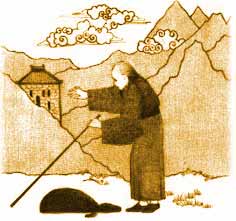
IGNORANCE (avijja)
Represented by an image of a blind woman who blunders forward, unable to see where she is going. So ignorance is blindness, not seeing. It is a lack of insight into the reality of things.
This Pali word “avijja” is a negative term meaning “not knowing completely” but it does not mean “knowing nothing at all.” This kind of unknowing is very special and not concerned with ordinary ways or subjects of knowledge, for here what one does not know are the Four Noble Truths, one does not see them clearly in one’s own heart and one’s own life. In past lives, we did not care to see ‘dukkha’ (1), so we could not destroy ‘the cause of dukkha’ (2) or craving which has impelled us to seek more and more lives, more and more pleasures. ‘The cessation of dukkha’ (3) which perhaps could have been seen by us in past lives, was not realised, so we come to the present existence inevitably burdened with dukkha. And in the past we can hardly assume that we set our feet upon the ‘practice-path leading to the cessation of dukkha’ (4) and we did not even discover Stream-entry. We are now paying for our own negligence in the past.
And this unknowing is not some kind of first cause in the past, for it dwells in our hearts now. But due to this unknowing, as we shall see, we have set in motion this wheel bringing round old age and death and all other sorts of dukkha. Those past “selves” in previous lives who are in the stream of my individual continuity did not check their craving and so could not cut at the root of unknowing. On the contrary they made kamma, some of the fruits of which in this present life I, as their causal resultant, am receiving.
The picture helps us to understand this: a blind old woman (avijja is of feminine gender) with a stick picks her way through a petrified forest strewn with bones. It is said that the original picture here should be an old blind she-camel led by a driver, the beast being one accustomed to long and weary journeys across inhospitable country, while its driver could be craving. Whichever simile is used, the beginninglessness and the darkness of unknowing are well suggested. We are the blind ones who have staggered from the past into the present — to what sort of future?
Depending on the existence of unknowing in the heart there was volitional action, kamma or abhisankhara, made in those past lives.
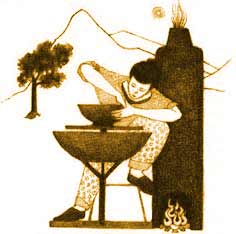
VOLITIONAL FORMATIONS (sankhara)
Represented by a potter. Just as a potter forms clay into something new, an action begins a sequence that leads to new consequences. Once put into motion, the potter’s wheel continues to spin without much effort. Likewise, an action creates a predisposition in the mind.
Intentional actions have the latent power within them to bear fruit in the future – either in a later part of the life in which they were performed, in the following life, or in some more distant life, but their potency is not lost with even the passing of aeons; and whenever the necessary conditions obtain that past kamma may bear fruit. Now, in past lives we have made kamma, and due to our ignorance of the Four Noble Truths we have been “world-upholders” and so making good and evil kamma we have ensured the continued experience of this world.
Beings like this, obstructed by unknowing in their hearts have been compared to a potter making pots: he makes successful and beautiful pottery (skillful kamma) and he is sometimes careless and his pots crack and break up from various flaws (unskillful kamma). And he gets his clay fairly well smeared over himself just as purity of heart is obscured by the mud of kamma. The simile of the potter is particularly apt because the word ‘Sankhara’ means “forming,” “shaping,” and “compounding,” and therefore it has often been rendered in English as “Formations.”
Depending on the existence of these volitions produced in past lives, there arises the Consciousness called “relinking” which becomes the basis of this present life.
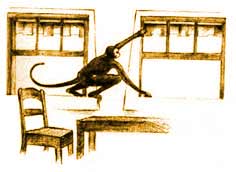
CONSCIOUSNESS (vinnana)
The rebirth consciousness or “consciousness that links on”, is represented by a monkey going from window to window. This represents a single consciousness perceiving through the various sense organs. The monkey represents the very primitive spark of sense-consciousness which is the first moment in the mental life of the new being.
This relinking consciousness may be of different qualities, according to the kamma upon which it depends. In the case of all those who read this, the consciousness “leaping” into a new birth at the time of conception, was a human relinking consciousness arising as a result of having practiced at least the Five Precepts, the basis of “humanness” in past lives. One should note that this relinking consciousness is a resultant, not something which can be controlled by will. If one has not made kamma suitable for becoming a human being, one cannot will, when the time of death comes round, “Now I shall become a man again!” The time for intentional action was when one had the opportunity to practice Dhamma. Although our relinking- consciousness in this birth is now behind us, it is now that we can practice Dhamma and make more sure of a favourable relinking consciousness in future — that is, if we wish to go on living in Samsara.
This relinking-consciousness is the third constituent necessary for conception, for even though it is the mother’s period and sperm is deposited in the womb, if there is no “being” desiring to take rebirth at that place and time there will be no fertilisation of the ovum.
Dependent upon relinking-consciousness there is the arising of Mind-body.
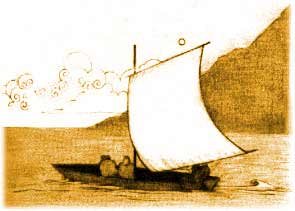
MIND - BODY (nama-rupa)
Depicted by people sitting in a boat with one of them steering. The boat symbolises form, and its occupants, the mental aggregates.
This is not a very accurate translation but gives the general meaning. There is more included in rupa that is usually thought of as body, while mind is a compound of feeling, perception, volition and consciousness. This mind and body is two interactive continuities in which there is nothing stable. Although in conventional speech we talk of “my mind” and “my body,” implying that there is some sort of owner lurking in the background, the wise understand that laws govern the workings of both mental states and physical changes and mind cannot be ordered to be free of defilements, nor body told that it must not grow old, become sick and die.
But it is in the mind that a change can be wrought instead of drifting through life at the mercy of the inherent instability of mind and body. So in the illustration, mind is doing the work of punting the boat of psycho-physical states on the river of cravings, while body is the passive passenger. The Tibetan picture shows a coracle being rowed over swirling waters with three (? or four) other passengers, who doubtless represent the other groups or aggregates (khandha).
With the coming into existence of mind-body, there is the arising of the Six Sense-spheres.

SIX SENSE - SPHERES (salayatana)
Depicted by a house with six windows and a door. The senses are the ‘portals’ whereby we gain our impression of the world. Each of the senses is the manifestation of our desire to experience things in a particular way.
A house with six windows is the usual symbol for this link. These six senses are eye, ear, nose, tongue, touch and mind, and these are the bases for the reception of the various sorts of information which each can gather in the presence of the correct conditions. This information falls under six headings corresponding to the six spheres: sights, sounds, smells, tastes, tangibles and thoughts. Beyond these six spheres of sense and their corresponding six objective spheres, we know nothing. All our experience is limited by the senses and their objects with the mind counted as the sixth. The five outer senses collect data only in the present but mind, the sixth, where this information is collected and processed, ranges through the three times adding memories from the past and hopes and fears for the future, as well as thoughts of various kinds relating to the present. It may also add information about the spheres of existence which are beyond the range of the five outer senses, such as the various heavens, the ghosts and the hell-states. A mind developed through collectedness (samadhi) is able to perceive these worlds and their inhabitants.
The six sense-spheres existing, there is Contact.
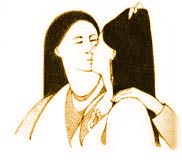
CONTACT (phassa)
A couple embracing depicts the contact of the sense organs with there objects. With this link, the psychophysical organism begins to interact with the world. The sensuous impression is symbolised by a kiss. This indicates that there is a meeting with an object and a distinguishing of it prior to the production of feeling.
This means the contact between the six senses and the respective objects. For instance, when the necessary conditions are all fulfilled, there being an eye, a sight-object, light and the eye being functional and the person awake and turned toward the object, there is likely to be eye-contact, the striking of the object upon the sensitive eye-base. The same is true for each of the senses and their type of contact. The traditional symbol for this link shows a man and a woman embracing.
In dependence on sensuous impressions, arises Feeling.
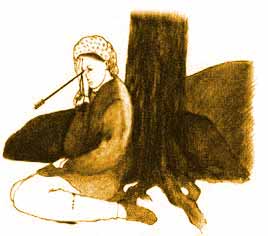
FEELING (vedana)
Symbolised by an eye pierced by an arrow. The arrow represents sense data impinging on the sense organs, in this case the eye. In a very vivid way, the image suggests the strong feelings which sensory experience evokes — although only painful feeling is here implied, both painful and pleasant are intended. Even a very small condition causes a great deal of feeling in the eye. Likewise, no matter what kind of feeling we experience, painful or pleasurable, we are driven by it and conditioned by it.
When there have been various sorts of contact through the six senses, feelings arise which are the emotional response to those contacts. Feelings are of three sorts: pleasant, painful and neither pleasant nor painful. The first are welcome and are the basis for happiness, the second are unwelcome and are the basis for dukkha while the third are the neutral sort of feelings which we experience so often but hardly notice.
But all feelings are unstable and liable to change, for no mental state can continue in equilibrium. Even moments of the highest happiness whatever we consider this is, pass away and give place to different ones. So even happiness which is impermanent based on pleasant feelings is really dukkha, for how can the true unchanging happiness be found in the unstable? Thus the picture shows a man with his eyes pierced by arrows, a strong enough illustration of this.
When feelings arise, Cravings are (usually) produced.

CRAVING (tanha)
Represented by a person drinking beer. Even though it harms you, no matter how much you drink, you just keep on drinking. Also known as attachment, it is a mental factor that increases desire without any satisfaction.
Up to this point, the succession of events has been determined by past kamma. Craving, however, leads to the making of new kamma in the present and it is possible now, and only now, to practice Dhamma. What is needed here is mindfulness (sati), for without it no Dhamma at all can be practiced while one will be swept away by the force of past habits and let craving and unknowing increase themselves within one’s heart. When one does have mindfulness one may and can know “this is pleasant feeling,” “this is unpleasant feeling,” “this is neither pleasant nor unpleasant feeling” — and such contemplation of feelings leads one to understand and beware of greed, aversion and delusion, which are respectively associated with the three feelings. With this knowledge one can break out of the Wheel of Birth and Death. But without this Dhamma-practice it is certain that feelings will lead on to more cravings and whirl one around this wheel full of dukkha. As Venerable Nagarjuna has said:
“Desires have only surface sweetness,
hardness within and bitterness deceptive as the kimpa-fruit.
Thus says the King of Conquerors.
Such links renounce they bind the world
Within samsara’s prison grid.
If your head or dress caught fire
in haste you would extinguish it.
Do likewise with desire.
Which whirls the wheel of wandering-on
and is the root of suffering.
No better thing to do!”
– L.K. 23, 104
In Sanskrit, the word trisna (tanha) means thirst, and by extension implies “thirst for experience.” For this reason, craving is shown as a toper guzzling intoxicants and in the picture has been added more bottles representing craving for sensual sphere existence and the craving for the higher heavens of the Brahma-worlds which are either of subtle form, or formless.
Where the kamma of further craving is produced there arises Grasping.
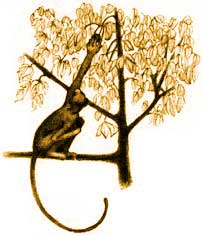
GRASPING(upadana)
Represented by a monkey reaching for a fruit. Also known as clinging, it means mentally grabbing at an object one desires.
This is the mental state that clings to or grasps the object. Because of this clinging which is described as craving in a high degree, man becomes a slave to passion.
Upadana is fourfold: 1. Attachment to sensual pleasures; 2. Attachment to wrong and evil views; 3. Attachment to mere external observances, rites and rituals; and 4. Attachment to self, an erroneous lasting soul entity. Man entertains thoughts of craving, and in proportion as he fails to ignore them, they grow till they get intensified to the degree of tenacious clinging.
This is an intensification and diversification of craving which is directed to four ends: sensual pleasures, views which lead astray from Dhamma, external religious rites and vows, and attachment to the view of soul or self as being permanent. When these become strong in people they cannot even become interested in Dhamma, for their efforts are directed away from Dhamma and towards dukkha. The common reaction is to redouble efforts to find peace and happiness among the objects which are grasped at. Hence both pictures show a man reaching up to pick more fruit although his basket is full already.
Where this grasping is found there Becoming is to be seen.
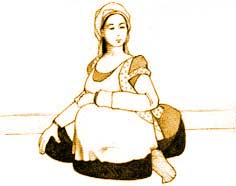
BECOMING (bhava)
Represented by a woman in late pregnancy. Just as she is about to bring forth a fully developed child, the karma that will produce the next lifetime is fully potentialized though not yet manifest.
With hearts boiling with craving and grasping, people ensure for themselves more and more of various sorts of life, and pile up the fuel upon the fire of dukkha. The ordinary person, not knowing about dukkha, wants to stoke up the blaze, but the Buddhist way of doing things is to let the fires go out for want of fuel by stopping the process of craving and grasping and thus cutting off Ignorance at its root. If we want to stay in samsara we must be diligent and see that our ‘becoming’, which is happening all the time shaped by our kamma, is ‘becoming’ in the right direction. This means ‘becoming’ in the direction of purity and following the white path of Dhamma-practice. This will contribute to whatever we become, or do not become, at the end of this life when the pathways to the various realms stand open and we ‘become’ according to our practice and to our death-consciousness.
In the presence of Becoming there is arising in a new birth.
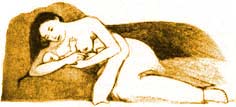
BIRTH (jati)
This link is represented by the very explicit image of a woman giving birth to a child.
Birth means the appearance of the five aggregates (material form, feeling, perception, formation and consciousness)in the mother’s womb.
Birth, as one might expect, is shown as a mother in the process of childbirth, a painful business and a reminder of how dukkha cannot be avoided in any life. Whatever the future life is to be, if we are not able to bring the wheel to a stop in this life, certainly that future will arise conditioned by the kamma made in this life. But it is no use thinking that since there are going to be future births, one may as well put off Dhamma practice until then — for it is not sure what those future births will be like. And when they come around, they are just the present moment as well. So no use waiting!
Venerable Nagarjuna shows that it is better to extricate oneself:
“Where birth takes place,
quite naturally are fear,
old age and misery,
disease, desire and death,
As well a mass of other ills.
When birth’s no longer brought about.
All the links are ever stopped.”
– L.K. 111
Naturally where there is Birth, is also Old-age and Death.
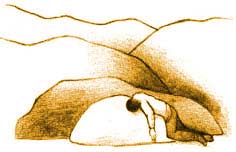
AGEING AND DEATH (jara-marana)
The final link is represented by a dying person. Ageing is both progressive, occurring every moment of our lifetime, and degenerative which leads to death.
In future one is assured, given enough of Unknowing and Craving, of lives without end but also of deaths with end. The one appeals to greed but the other arouses aversion. One without the other is impossible. But this is the path of heedlessness. The Dhamma-path leads directly to Deathlessness, the going beyond birth and death, beyond all dukkha.
We are well exhorted by the words of Acharya Nagarjuna:
“Do you therefore exert yourself:
At all times try to penetrate Into the heart of these Four Truths;
For even those who dwell at home,
they will, by understanding them ford the river of (mental) floods.”
– L.K. 115
This is a very brief outline of the workings of this wheel which we cling to for our own harm and the hurt of others. We are the makers of this wheel and the turners of this wheel, but if we wish it and work for it, we are the ones who can stop this wheel.
Conclusion
This Wheel of Life teaches us and reminds us of many important features of the Dhamma as it was intended to by the teachers of old. Contemplating all its features frequently helps to give us true insight into the nature of Samsara. With its help and our own practice we come to see Dependent Arising in ourselves. When this has been done thoroughly all the riches of Dhamma will be available to us, not from books or discussions, nor from listening to others’ explanations…
The Exalted Buddha has said:
“Whoever sees Dependent Arising, he sees Dhamma;
Whoever sees Dhamma, he sees Dependent Arising.”
Anicca vata sankhara
uppada vayadammino
Uppajjitva nirujjhant
tesam vupasamo sukho.
Conditions truly they are transient
With the nature to arise and cease
Having arisen, then they pass away
Their calming, cessation is happiness.

